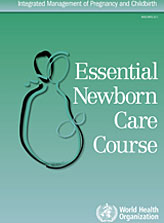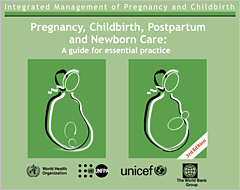Essential newborn care
 |
Essential newborn care courseThe Essential Newborn Care Course aims to ensure health workers have the skills and knowledge to provide appropriate care at the most vulnerable period in a baby’s life. Health workers are taught to use WHO’s Pregnancy, Childbirth, Postpartum and Newborn Care: A guide for essential practice – and particularly the sections concerned with newborn care – that provides up-to-date evidence-based information and management of babies with a range of needs in the initial newborn period. |
 |
Pregnancy, childbirth, postpartum and newborn care: A guide for essential practice (3rd edition)Pregnancy, childbirth, postpartum and newborn care: a guide for essential practice (3rd edition) (PCPNC), has been updated to include recommendations from recently approved WHO guidelines relevant to maternal and perinatal health. These include pre-eclampsia & eclampsia; postpartum haemorrhage; postnatal care for the mother and baby; newborn resuscitation; prevention of mother-to- child transmission of HIV; HIV and infant feeding; malaria in pregnancy, interventions to improve preterm birth outcomes, tobacco use and second-hand exposure in pregnancy, post-partum depression, post-partum family planning and post abortion care. |
 |
WHO recommendations on newborn healthThis compilation of WHO recommendations on newborn health produced by all related departments are the ones that have been approved by the Guidelines Review Committee of WHO. These series of recommendations are those responding to the “what” questions i.e. what health interventions a newborn should receive and when s/he should receive them. |
Prematurity
Globally 2.4 million children died in the first month of life in 2020. There are approximately 6700 newborn deaths every day, amounting to 47% of all child deaths under the age of 5 years, up from 40% in 1990. Most neonatal deaths (75%) occur during the first week of life, and in 2019, about 1 million newborns died within the first 24 hours. Preterm birth and childbirth-related complications were the cause of most neonatal deaths in 2019.
Preterm infants are at higher risk of dying due to complications such as respiratory problems, feeding difficulties, poor regulation of body temperature and recurrent infections. The burden of morbidity and mortality resulting from prematurity could be reduced by adopting and implementing priority evidence-based interventions such as:
ensuring antenatal care for all pregnant women, including screening for, and diagnosis and treatment of infections, such as HIV and sexually transmitted infections, nutritional support and counselling;
providing screening and management of pregnant women at higher risk of preterm birth – multiple pregnancies, diabetes, high blood pressure, or with a history of previous preterm birth;
managing effectively preterm labour, especially provision of antenatal corticosteroids to reduce the risk of breathing difficulties in premature babies. This intervention alone could save around 370 000 lives each year;
promoting behavioural and community interventions to reduce smoking, secondhand smoke exposure, and other pollutants; and preventing violence against women by intimate partners;
reducing non-medically indicated inductions of labour and caesarean births, especially before 39 completed weeks of gestation.
In the Eastern Mediterranean Region, given the notable reduction in number of deaths due to pneumonia and diarrhoea, preterm birth complications have become the leading cause of death among children under-5 in the Region. It is estimated that around 160 000 babies die due to preterm birth complications, comprising nearly 20% of under-5 deaths.
Data from countries show significant variations on the contribution of prematurity to 0-4 years deaths. In Bahrain and Kuwait, for instance, 35% are attributed to preterm complications while in a country like Somalia – where post-neonatal causes of death are more prevalent – this figure goes down to 8.5%. However, it is important to highlight that prematurity represents a public health problem in all Member States in the Region.
Table 1. Deaths due to preterm birth complications as percentage of all under-5 deaths
|
Country |
Percentage of deaths due to prematurity |
|
Kuwait |
35 |
|
Bahrain |
35 |
|
Jordan |
26 |
|
Qatar |
25 |
|
Saudi Arabia |
24 |
|
Lebanon |
24 |
|
United Arab Emirates |
24 |
|
Tunisia |
24 |
|
Libya |
23 |
|
Pakistan |
22 |
|
Morocco |
22 |
|
Islamic Republic of Iran |
22 |
|
Iraq |
21 |
|
Egypt |
21 |
|
Djibouti |
21 |
|
Sudan |
21 |
|
Oman |
19 |
|
Yemen |
19 |
|
Afghanistan |
19 |
|
Syria |
18 |
|
Palestine |
16* |
|
Somalia |
8.5 |
*Figure is for West Bank only and reflects percentage of premature deaths among infant deaths, 2016 data
Reaching the every newborn national 2020 milestones
 Reaching the every newborn national 2020 milestones: country progress, plans and moving forward
Reaching the every newborn national 2020 milestones: country progress, plans and moving forward
In 2014, at the Sixty-seventh World Health Assembly, 194 Member States endorsed the Every Newborn: an action plan to end preventable deaths, a road map of strategic actions to end preventable newborn mortality and stillbirths and contribute to reducing maternal mortality and morbidity.
The Every Newborn Action Plan presents evidence-based solutions and sets out a clear path to 2020 with 8 specific milestones for what needs to be done differently to greatly reduce mortality rates and improve maternal and newborn health by 2030. Member States requested that WHO’s Director General monitors progress towards the achievement of the global goal and targets and reports periodically to the Health Assembly until 2030.
For the 2017 World Health Assembly, reporting on the Every Newborn Resolution is part of the progress reporting on the Global Strategy for Women’s Children’s and Adolescent Health. Achieving the goals and targets set out in the Sustainable Development Goals (2016-2030) and the Global Strategy for Women’s, Children’s and Adolescents’ Health (2016-2030) is underpinned by achieving the Every Newborn National and Global Milestones by 2020.
To complement the Global Strategy progress reporting, Reaching the every newborn national 2020 milestones report provides a detailed look at country leadership and action toward the Every Newborn National Milestones by 2020. Countries have taken the initiative to show the way forward and have demonstrated significant progress. As part of monitoring this progress, countries have adopted the Every Newborn Tracking Tool. This report presents a compilation of the data collated by the Every Newborn Tracking Tool in 2016, when 51 countries adopted the tool; it also spotlights examples of specific country activity for each National Milestone.
Finally, Global Milestones for 2020 were part of the Every Newborn Action Plan to guide global and regional work in support of country efforts and this report highlights relevant progress towards those Global Milestones.
Related links
Reaching the every newborn national 2020 milestones: country progress, plans and moving forward


